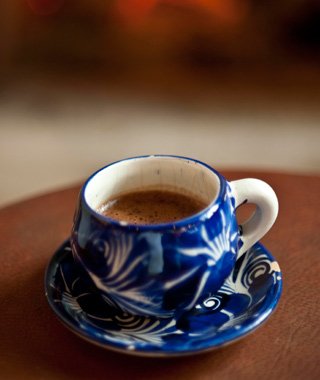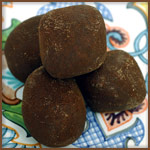 Photo: Missy Wolf c/o Kakawa Chocolate HouseIt's a funny thing about chocolate.
Photo: Missy Wolf c/o Kakawa Chocolate HouseIt's a funny thing about chocolate.
I like chocolate. I even love chocolate at times. But I will be honest. Once it starts getting discussed in "Fair Trade certified...90% cacao" terms, I kind of zone out. I am not trying to be disrespectful, because I realize that Fair Trade and purity are respectable characteristics of chocolate. But I find myself wondering "when do I get to eat it?".
But even though I admittedly don't "know" chocolate, I know that sometimes a chocolate comes along that kind of makes me hum a little bit like a tuning fork. It's really an interesting sensation. "Chocolate buzz"?
 Photo: Kakawa Chocolate HouseAnd recently, I had such an experience with the drinking chocolates by Kakawa Chocolate House of New Mexico.
Photo: Kakawa Chocolate HouseAnd recently, I had such an experience with the drinking chocolates by Kakawa Chocolate House of New Mexico.
Called "elixirs" (oh how worldly!), they come in little round cakes that can be melted with water or milk or cream (see how I resisted calling them "balls", though just look at them...), and have an interesting backstory:
The drinking chocolate elixirs at Kakawa are one of our most famous and popular items. These elixirs are deep, rich drinking chocolates based on recipes we have recreated from historical sources. They have been described as a kind of "time traveling" for thepalette, and range from pre- Colombian drinking chocolate to colonial American drinking chocolate as well as a few of our own inventions.
We first re-created several elixirs based upon the chocolate that was consumed in pre-Colombian
America. These exceptional drinks were reserved for the powerful elite and for special ceremonies (Cortez, for example, drank chocolate with Montezuma when he first arrived in Tenochtitlan). These elixirs are full of intense flavor, highly spiced with a wide variety of native herbs, flowers, and chiles.
and, even further, they appeal to food geeks because they are available in historically accurate bites (or sips): Mesoamerican varieties (unsweetened, like the Aztec Warriors would have imbibed), Historic European varieties (I recently bought SpyMom the Marie-Antoinette era variety; other types include the 1631 Spanish Elixir, based on a recipe from 1631 written by Antonio Colmenero de Ledesma which describes how the Spaniards preferred their chocolate), and a most fascinating 1790s Jeffersonian Elixir, a sort of crossover to what we now consider american hot chocolate, described thusly:
Representative of the historic drinking chocolate of the American colonies from the early 1700s to the mid 1800s. The first chocolate company in America was started by the Walter Baker Co. in Massachusetts in 1765. Thomas Jefferson loved chocolate and consumed it at Monticello. Due to its expense American drinking chocolate was simplified with less chocolate used. The drink became thinner and sweeter then European chocolate. Modern American hot chocolate is a direct descendant of this historic evolution.
There are also "Contemporary" versions, and while delightful, weren't quite as compelling to this spy in terms of doing the whole "tasting time travel" thing.
So, we've established that this drinking chocolate is interesting. But how does it taste?
The Mesoamerican varieties are compelling: deep and dark, and spicy--but to American hot chocolate drinkers, these are going to taste...well, maybe strange. For one thing, most of them are unsweetened. They're more like an espresso or turkish coffee--with a different, richer taste--and they will give you a powerful energy kick, but they're definitely not like the creamy variety at Cafe Angelina, for instance. So while I loved trying them for historical perspective, I don't think they're going to become part of my regular rotation.
For me, the favored varieties were the European ones--especially the 1631 Spanish variety and the Jeffersonian one. Both were accessible to my sweet-starved palate, but still dark and complex enough that you could see how the transition was made from the unsweetened varieties to the sweeter American style. But they were still dark and slightly bitter, so there is no mistaking these for, say, hot chocolate from 7-11.
One thing was true for all of the varieties, though: with such a concentrated, pure chocolate flavor, it is impossible to drink these "elixirs" without getting a total buzz afterward. Maybe that's why the Aztecs dug it so much?
Moreover though, what is clear is that Kakawa Chocolates is passionate not only about what they are doing, but about preserving the history of chocolate and educating their consumers.
And that, friends, is totally sweet.
Shop on the Kakawa site for elixirs as well as confections, truffles, and caramels. They're online here and on facebook here.
